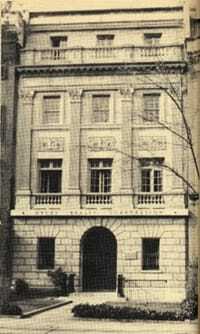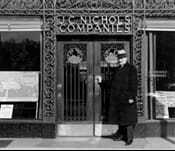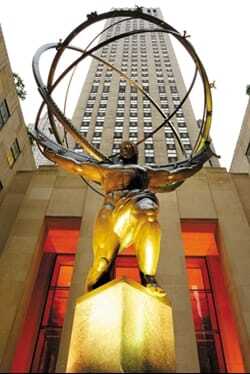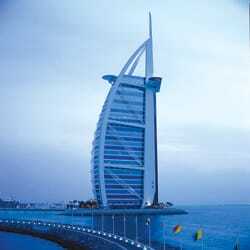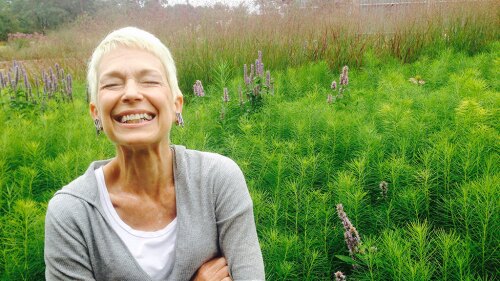1930s and 1940s: The Founding Decades and the Early Postwar Years
Highlights: A fledgling ULI emerges as an independent organization designed to help U.S. land developers—a place where practical knowledge is gathered, shared, and expanded.
| 1942: The Drury Realty Buildingat 1737 K Street, N.W.,becomes ULI’s headquartersafter its move to Washington, D.C. |
December 14, 1936: The National Real Estate Foundation for Practical Research and Education—the predecessor to the Urban Land Institute—is chartered in Illinois, with Walter S. Schmidt as its first president. The model is that of a real estate college—a school of urbiculture—that could stand as an objective and recognized source of research and education, governed by a board of real estate professionals.
1937: The headquarters is established at 22 West Monroe Street in Chicago.
December 20, 1939: The group’s name is changed to the Urban Land Institute and its charter is amended; ULI’s first annual budget is $60,000.
1940: ULI prints its first two publications: Decentralization—What Is It Doing to Our Cities? and The Present and Ultimate Effect of Decentralization upon American Cities.
1940: An early internal bulletin outlines the group’s mission: “The Urban Land Institute . . . has been established to assist American cities in their problems of planning, replanning, construction, and reconstruction.”
ULI Chairs 1940s 1950s 1960s 1970s 1980s 1990s 2000s 2010s |
1941: First ULI conference is held at the Massachusetts Institute of Technology in Boston, on the topic “The Principles of City Re-Planning.” The conference focuses mainly on planning for post–World War II America and how to solve the problems of inner-city blight. First membership figure (207) is recorded.
1941: Urban Land magazine begins publication on July 21, 1941, as the four-page, typewritten News Bulletin. (A few months later, the title is shortened to Bulletin.) Its forward-looking legend is “To Obtain Post-War Replanning and Rebuilding of Cities.”
1942: ULI first enters the advocacy field with the publication “Outline for a Legislative Program to Rebuild Our Cities” and begins operating out of its first Washington, D.C., headquarters on K Street.
1944: ULI forms its first council, the Community Builders’ Council. Organized by J.C. Nichols and Hugh Potter, the council is devoted to addressing the issues that American cities would face during the post–World War II suburban building boom. The council’s work constitutes an early example of the sharing and lessons-learned approach that later comes to define much of ULI’s council and advisory services programs, conferences, and publications.
1945: Central Business District Council (ULI’s second council) is formed to stimulate vigorous and attractive development of CBDs. (Its name is changed to Central City Council in 1961.)
1947: Panel Advisory Service program is established, embodying the ULI founding principle of sharing by providing interdisciplinary panels of ULI members—all of whom donate their time—to help communities address land use and real estate development issues. The first panel is conducted for the city of Louisville, Kentucky. (This program is later renamed Advisory Services; for future panel reports, see the “Publications and Panel Reports” timeline.)
1950s Growth of Membership and Advisory Services
Highlights: ULI and its growing numbers of members introduce pioneering concepts, including the shopping center, planned industrial districts, and planned communities; members of the Institute’s councils share “mistakes made, lessons learned” and offer advice to others through panel services and plan analysis sessions.
1950: J.C. Nichols Foundation—the precursor of what eventually becomes the ULI Foundation—is established to make annual awards to university students for practical research in the field of community improvement.
1959: ULI begins its first shopping center costs study.
1960s The Research Years
Highlights: The development of concepts and basic data on taxation/land use relationships; pioneering new approaches to residential land development, planned unit development, homeowners associations, and open-space communities; by 1965, more than 50 panel studies have been completed.
1960: ULI’s research program is established; its initial objective is “to develop a better understanding of the underlying forces which produce urban change.” Five related, multiyear studies include a comparative study of land uses in declining and stable areas; real estate taxation, the use and power of eminent domain; zoning and subdivision regulation; and urban expressways.
1964: Ford Foundation awards ULI a $25,000 grant to measure and analyze three basic dimensions of metropolitan area growth and change.
1965: ULI’s sustaining members gather outside the United States for the first time, holding their fourth biennial meeting in Mexico City.
| 1944: J.C. Nichols helpsorganize ULI’s first council. |
1967: Community Builders Council hosts the Institute’s first European study tour; 42 members visit 15 cities in 32 days.
1969: ULI holds its first annual sustaining member meeting, the Land Use Symposium, in Miami; a record 534 members attend.
1970s Expanding Programs
Highlights: Councils double in number, the Institute’s flagship awards program is born. In the early 1970s, the ULI Fellows program is established to recognize and attract leading academic researchers and educators in the fields of real estate development and finance.
1970: Urban Land Research Foundation (which later becomes the Urban Land Foundation and finally the ULI Foundation) is created to enhance ULI’s research effort and help meet the rising need for an expanding, more accessible body of development information. The ULF’s original 17 governors each demonstrate their commitment to the Institute’s future by contributing $50,000 to the foundation’s endowment. Its first two grants are to help expand the Community Builders Handbook series.
1970: Community Builders Council hosts the Institute’s first study tour of “the Orient, Far East, and South Pacific.”
1974: ULI cosponsors (with the Financial Times) a two-day World Property Conference in London; membership grows to 6,347.
1976: During its 40th anniversary year, the Institute’s annual budget grows to more than $1.5 million.
1979: ULI Awards for Excellence, the flagship award program for the real estate industry, begins. The first winner is the Galleria in Houston. In its first three years, the program grants one award each year.
1979: The number of councils expands from six to nine.
1980s Expanding Outreach at the Local and Regional Levels
Highlights: A network of regional councils is established to support ULI’s work at the local level; membership grows from less than 9,500 in 1985 to 14,000 by the close of the decade.
1982: Awards for Excellence program expanded to grant two awards each year, one for a large-scale project and one for a small-scale project.
1983: Regional council program is created. Beginning with only seven councils—Atlanta, Boston, Chicago, Kansas City, San Antonio, San Francisco, and Seattle—the program eventually grows to include more than 50 district councils in North America (including one in Mexico and two in Canada), and more than a dozen national councils around the globe.
1986: ULI’s first annual Real Estate School is held. The school offers current and aspiring real estate professionals opportunities to learn about real estate development from expert faculty in intensive, four-day courses. Emphasizing a real-world perspective, each course provides students with practical, hands-on knowledge and information.
1988–1999: Annual budget grows to $11.5 million.
1989: Heritage Award is introduced to the Awards for Excellence program to recognize projects that have established an industry standard for excellence and have been completed for at least 25 years. The first Heritage Award goes to New York City’s Rockefeller Center.
1990s Going Local and Global
Highlights: Membership begins the decade above 15,000, drops to 12,372 in 1993 before beginning a slow but steady rise to close the decade back to around 15,000; district councils begin local outreach efforts, focusing on “ULI in the community"; global outreach efforts expand exponentially; smart growth focus begins.
1990: Six new councils are established, including the International Council, bringing the total number of councils to 25 and the number of council members to 1,250.
1990: Dilemmas of Development, ULI’s first high school curriculum unit, is introduced to help students explore the decisions and choices that must be made in the planning and approval process for a large suburban development process.
1991: UrbanPlan, ULI’s second high school curriculum unit, is developed, produced, and distributed, funded in part by a National Geographic Society Education Foundation grant.
1992: The Institute’s first two European district councils are established in London and Barcelona.
February 1992: Richard M. Rosan is hired as the executive vice president of ULI (his title is later changed to president). Rosan comes to ULI following a 22-year career in the public and private sector in New York City, including service as the city’s economic development director. He replaces David E. Stahl, who held the job for four and a half years (Stahl also held the post for four years in the mid-1970s.)
1993: ULI kicks off a three-year, $1 million Inner-City Community Building program to expand the Institute’s participation in urban revitalization efforts.
1994: Education program offers professional development certificates (the Real Estate Development Certificate and the Real Estate Development Finance Certificate) for the first time to real estate professionals who complete the required combination of ULI Real Estate School courses, workshops, and/or seminars. Since then, more than 600 people have applied to the program, and more than 200 have earned certificates.
1994: First annual Bowen H. “Buzz” McCoy Symposium on Real Estate Finance brings together some of the best minds in the real estate business to discuss trends in the equity markets, global capital markets, and financial policy issues.
1994: An International Award is introduced to the Awards for Excellence program, for a project outside the United States and Canada. The first International Award goes to Broadgate in London.
| 1989: Rockefeller Center receives the first Heritage Award. |
1995: Urban Land Foundation celebrates its 25th anniversary, having granted a total of almost $4 million to ULI’s research, education, and advisory services programs.
1995: ULI Online premiers, providing members direct electronic access to key resources, experts, and services.
1996: The ULI Senior Resident Fellows program is created to enhance the Institute’s role as an influential voice in the real estate industry and improve the quality of land use and development worldwide. It is established with a $1 million endowment from Joseph C. Canizaro to create the Joseph C. Canizaro Chair for Public Policy. William H. Hudnut III is hired to fill the position. (Subsequent gifts from J. Ronald Terwilliger; the Matthew and Carolyn Bucksbaum Family Foundation; and the Martin Bucksbaum Family Foundation, James D. Klingbeil, and numerous ULI members in honor of Charles Fraser, followed in 2001, 2002, and 2004, respectively, to endow other senior resident fellow positions. As of 2011, ULI had four senior resident fellows who specialize in real estate finance, housing, environmental issues, and urban development.)
1996: First ULI Mayors’ Forum is held in Washington, D.C.; this and future forums offer mayors and other city officials an opportunity to meet with private sector development leaders to seek solutions to urban problems.
1996: ULI headquarters relocates to 1025 Thomas Jefferson Street, N.W., Washington, D.C.
1998: Annual operating income increases to almost $30 million (from $10 million in 1992).
2000s Facing the Challenges of a New Millennium
Highlights: Membership starts the decade at nearly 16,000, rises exponentially to more than 40,000 in 2008—sparked in part by concurrent gains in the general economy and the explosive growth of the real estate industry—before declining (after the recession begins) to just under 30,000 in 2010; funding from the ULI Foundation helps maintain ULI’s research and education programs through the economic downturn; the Institute’s presence expands worldwide—with offices in Europe and Asia—as well as online; focus on smart growth and sustainability continues; new programs, awards, and centers are created to anticipate and meet the evolving needs of the land use community in the 21st century.
July 2000: ULI J.C. Nichols Prize for Visionaries in Urban Development is established to recognize a person, or a person representing an institution, whose career demonstrates a commitment to the highest standards of responsible development. Joseph Riley, mayor of Charleston, South Carolina, is chosen as the first laureate. (For a list of laureates.)
July 2000: Number of councils grows again, to a total of 39, including Europe, Japan, and South America councils.
2001: ULI Europe office opens in Brussels, Belgium.
2001: First Young Leaders Group is established—to attract new members age 35 and younger—by the Houston District Council; within four years, the program has expanded to most district councils.
2002: The annual ULI/Gerald D. Hines Student Urban Design Competition is established; the first competition is held in spring.
2003: This competition offers graduate-level students the opportunity to form multidisciplinary teams and engage in a challenging exercise in responsible land use.
2004: ULI Europe office moves to London.
June 2004: ULI Awards for Excellence: Europe competition is inaugurated, with the same criteria and a similar selection process, juried by Europe-based ULI members.
November 2004: Community Action Grants program is created; six grants are awarded in the first funding round. The program awards up to $200,000 in seed capital from the ULI Foundation Annual Fund to district councils or individual council members for entrepreneurial programs that aim to improve urban growth in their communities.
2004: First online ULI Professional Development program—Financing and Investing in Real Estate—appears.
May 2005: ULI Awards for Excellence: Asia Pacific competition inaugurated
June 2005: First-ever World Cities Forum is held in London.
November 2005: After Hurricane Katrina, ULI works with Mayor Ray Nagin’s Bring New Orleans Back Commission to develop an overall framework for the city’s rebuilding process so city leaders could begin to develop detailed plans and strategies for its future.
November 2005: ULI Global Awards for Excellence competition inaugurated.
January 2006: Eight district councils receive grants to support the creation of alliances to promote smart growth development principles through a collaborative effort between the Environmental Protection Agency’s Development, Community, and Environment Division and ULI.
| 2007: First Middle East development seminar is held in Dubai. |
2006: Mission statement and guiding principles are expanded and updated.
2006: First professional development webinar offered.
2007: The ULI Foundation annual fund reaches $1 million.
2007: First Middle East development seminar is held in Dubai.
February 2007: ULI Terwilliger Center for Workforce Housing is created with a $5 million gift from former chairman J. Ronald Terwilliger—the largest individual contribution ever made to the Institute. The center aims to support the development of housing affordable to moderate-income workers.
April 2007: Staff is reorganized to create a global governance structure encompassing three regions worldwide (the Americas, Europe, and Asia Pacific).
November 2007: Asia Pacific office opens in Hong Kong.
November 2007: Washington, D.C., headquarters office receives Leadership in Energy and Environmental Design (LEED) certification from the U.S. Green Building Council.
December 2007: First Middle East professional development seminar—Fundamentals of Real Estate Modeling—held in Dubai.
April 2008: First professional development workshop held in Asia: Developing Sustainable Communities.
May 2008: ULI Daniel Rose Center for Public Leadership is created with a $5 million commitment from Daniel Rose; the center’s mission is to empower public sector leaders to envision, build, and sustain successful 21st-century communities by providing access to information, best practices, peer networks, and other resources to foster creative, efficient, and sustainable land use practices.
September 2008: ULI, along with several private and public sector partners, launches a new European joint venture, the Urban Investment Network, which combines city government leaders and institutional investors and developers in a new partnership aimed at driving up the rate of investment in Europe’s cities through public/private collaboration and innovation.
October 2008: First annual ULI/J. Ronald Terwilliger Workforce Housing Models of Excellence Awards are given to workforce housing developments that represent outstanding achievements in several areas, including innovative financing, unique construction methodologies, strong public/private partnerships, and replicability. In 2009, these are renamed the Jack Kemp Workforce Housing Models of Excellence Awards.
August 2009: Patrick L. Phillips, president and chief executive officer of ERA AECOM (formerly Economics Research Associates), is selected as ULI’s new chief executive officer; existing CEO Richard M. Rosan becomes president of the ULI Foundation.
September 2009: U.S. Department of Housing and Urban Development awards ULI—through the ULI Terwilliger Center for Workforce Housing—a $3.15 million grant to provide technical assistance for the federal government’s Neighborhood Stabilization Program, which assists communities with the acquisition, rehabilitation, and resale of foreclosed homes.
2009: ULI Center for Capital Markets and Real Estate is established.
March 2010: ULI Amanda Burden Urban Open Space Award is created to celebrate and promote vibrant, successful urban open spaces.
August 30, 2010: Urban Land online magazine launched, with most content made available only to ULI members.
2011: The ULI Foundation—with 260 governors, 17 special endowments, and a permanent endowment of nearly $50 million—provides a record $5.5 million to support more than 50 percent of ULI’s content programming for the year.
October 2011: Urban Land online magazine content unlocked and made available to any user of that media outlet.
June 2011: First annual ULI Real Estate Capital Markets Conference, titled “Real Estate Finance and Investment 2011: New Directions, New Connections,” is held in New York City.
July 2011: Two new council flights are added, bringing the total number of councils to 58, including 49 domestic and nine international councils.
October 25–28, 2011: ULI kicks off a yearlong celebration of its 75th anniversary at the Institute’s annual Fall Meeting and Urban Land Expo at the Staples Center in Los Angeles.

